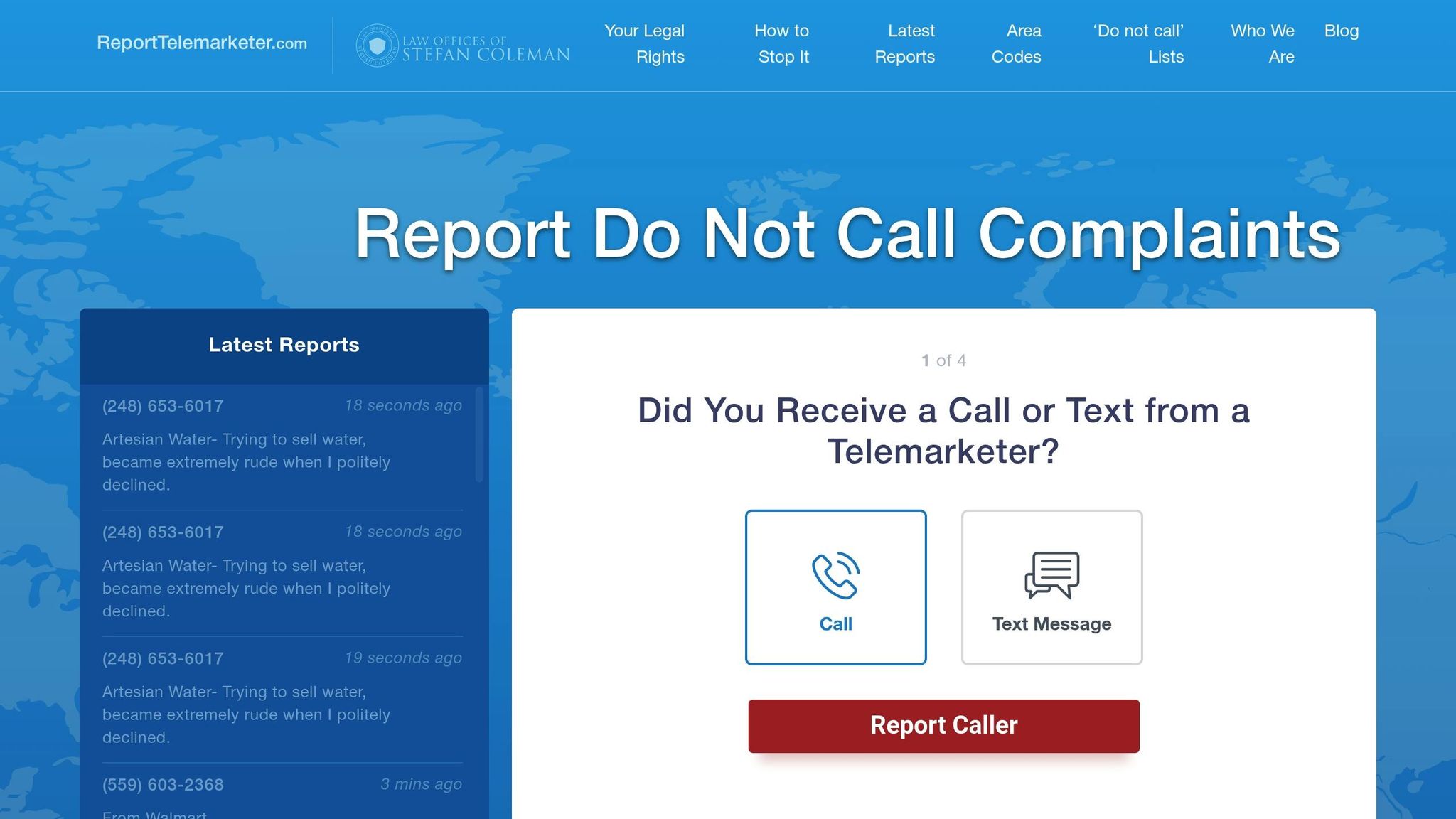
AI dialers are transforming telemarketing, but staying compliant with the 2025 TCPA rules is critical. Here’s what you need to know:
- Consent Rules: Written consent is now required for each specific company using AI dialers.
- Opt-Out Updates: Businesses must process opt-out requests across SMS, voice, and email within 10 days.
- State-Level Laws: States like California, Florida, and Texas have added unique requirements, such as disclosing AI use and banning certain AI features.
- Compliance Tools: Real-time consent verification, blockchain storage, and STIR/SHAKEN call authentication are key to avoiding fines.
Why it matters: Non-compliance can result in fines of $1,500 per violation or even $25,000 per day for state-level breaches. Businesses must act now to align their AI dialing systems with these updated regulations.
Call & Text Compliance in 2025: Get Regulation Ready
2025 TCPA Updates
The Federal Communications Commission (FCC) has rolled out new TCPA regulations for 2025, bringing changes that impact how businesses leverage AI dialers. These updates aim to protect consumers while offering businesses clear rules for using AI-driven calling systems.
AI Dialer Consent Rules
Starting January 27, 2025, the FCC’s one-to-one consent rule requires businesses to obtain written consent for each specific entity using AI dialers to contact consumers. This replaces the older practice of using blanket consent forms that applied to multiple "partner companies".
For example, mortgage lenders must now identify individual institutions in their consent forms and keep separate authorization records for each.
Updated Opt-Out Rules
From April 11, 2025, businesses must follow stricter opt-out procedures to make the process easier for consumers. Key updates include:
- Multiple opt-out channels: Consumers can opt out via SMS, voice, or email, and requests must be processed immediately.
- 10-day processing limit: All systems must reflect opt-out requests within 10 days.
- Real-time synchronization: Platforms must automatically update opt-out statuses across all communication channels.
Tools like Convoso‘s Click-to-Comply™ system enable businesses to track and manage opt-outs across various channels seamlessly.
State AI Dialing Laws
State-level regulations add another layer of complexity to AI dialer compliance. For instance:
- California’s SB 1003 requires businesses to disclose the use of AI during the first contact.
- Florida’s HB 747 bans emotion-detection AI in collection calls.
- Texas enforces strict controls on biometric voiceprint data used in AI systems.
"Dynamic disclosure forms showing real-time partner lists are now mandatory for multi-entity campaigns"
To help navigate these varying state rules, tools like Gryphon‘s StateTracker™ ensure businesses stay compliant with both federal and state AI dialing regulations.
These state-specific laws play a key role in shaping how compliance tools are developed and used.
TCPA Compliance Tools
Businesses are turning to modern tools to manage the challenges of AI dialer regulations and stay compliant with TCPA requirements.
Consent Tracking Systems
These systems help AI dialers adjust their calling behavior based on real-time consent updates. Features include timestamped, campaign-specific consent records, automated handling of consent revocations within 24 hours, and AI tools that identify gaps during lead processing.
For example, Phonexa‘s LMS Sync integrates consent documentation directly into contact records and blocks any unauthorized changes to compliance settings. Similarly, Salesforce‘s TCPA module uses AI to validate consent during lead acquisition, flagging potential issues and cutting consent-related violations by 43%.
Call Authentication Methods
STIR/SHAKEN protocols are now required for AI dialers to combat call spoofing. This system uses three levels of attestation to verify call authenticity:
| Attestation Level | Verification Type |
|---|---|
| Full (A) | Complete verification |
| Partial (B) | Identity only |
| Gateway (C) | Entry point |
Gryphon.ai reports a 68% drop in complaint rates after adopting these protocols. Their approach blends authentication with real-time compliance checks, ensuring every call meets TCPA standards. When paired with consent tracking systems, these protocols create a robust, multi-layered compliance framework.
Blockchain Consent Storage
Blockchain technology offers a reliable way to maintain audit-proof compliance records, complementing real-time consent verification tools. The Hyperledger Fabric system, endorsed by the Texas Attorney General, provides features like:
- Automated expiration of permissions
- Validation across state lines
- Timestamped records ready for audits
According to Convoso’s 2025 benchmark report, companies using blockchain-based consent storage see fewer than 2% of consents expiring or becoming invalid each month, thanks to automated reconfirmation workflows. This approach ensures a higher level of accuracy and compliance.
sbb-itb-a8d93e1
Consumer Rights and Reporting
As compliance tools advance, consumers now have improved ways to protect their rights. The 2025 TCPA amendments introduce stricter rules for AI dialers, requiring clear identification of artificial callers and ensuring opt-out requests are honored across all communication channels.
ReportTelemarketer.com

ReportTelemarketer.com simplifies the process of documenting violations by using call metadata to create FCC-ready reports. Their tools cross-check numbers against Do-Not-Call registries and consent records to identify TCPA breaches. Once a violation is confirmed, their legal team sends cease-and-desist letters for free.
These systems work alongside business compliance tools, creating a streamlined approach to tackling violations.
Know Your TCPA Rights
The updated 2025 TCPA rules outline specific obligations for AI-driven communications:
- Broader Opt-Out Options: Companies must process opt-out requests across all channels within 10 business days.
- State-Specific Rules: California introduces additional measures, including:
- Caller ID labels stating "AI-Powered Call"
- Clear disclosures about AI data usage
"Unchallenged violations establish dangerous precedents for AI dialer operators"
If you receive unwanted AI telemarketing calls, here’s what to do:
- Record the caller ID and note any AI disclosures.
- Use direct opt-out commands to revoke consent.
- Submit evidence through accredited platforms.
Experts also suggest using AI-specific call-blocking tools to prevent such calls. Calls supported by blockchain-recorded consent logs are more effective when reporting violations.
AI Dialer Implementation Issues
Integrating AI dialers while staying compliant with TCPA regulations presents operational hurdles in 2025. Addressing these effectively requires blending compliance tools with daily workflows.
Meeting Call Targets Without Violations
AI-driven call pacing must align with consent availability while adhering to strict compliance rules. Success hinges on three key metrics: 100% consent validation, less than 3% call abandonment, and processing opt-outs within 10 days.
These metrics depend heavily on seamless integration with consent tracking systems. For instance, Phonexa’s LMS Sync has proven effective by routing calls based on explicit consent. This approach not only ensures compliance but also boosts conversion rates by 33%.
Training Staff on TCPA Compliance
Proper training for staff is critical and should focus on:
- Real-time consent handling: Employees must know how to process immediate consent revocations across all communication channels.
- Multi-channel monitoring: Teams should be skilled in identifying opt-outs via calls, SMS, and emails.
- Manual compliance overrides: Staff must follow protocols for overriding automated systems when necessary.
This training works hand-in-hand with blockchain-based consent storage, ensuring human oversight complements technical safeguards. Regular audits and system checks help catch any potential errors.
Summary and Next Steps
As we look ahead to 2025, three key compliance requirements are shaping strategies for businesses:
Key Compliance Requirements for 2025
By 2025, businesses must adhere to these three critical pillars:
- Opt-Out Processing: Cross-channel opt-out requests must be processed within 10 days.
- Consent Alignment: Message content must strictly align with the original consent provided.
- AI Disclosure Protocols: Implementation of AI-specific disclosure rules tailored to individual state regulations.
These measures aim to safeguard consumer rights while allowing businesses to use AI-powered tools responsibly.
Implementation Framework
| Compliance Component | Requirement |
|---|---|
| Opt-Out Processing | Cross-channel verification of opt-out requests |
| AI Disclosure | Notifications customized to state-specific rules |
Financial Risks of Non-Compliance
Failing to meet these requirements could lead to severe penalties, including:
- Fines of $1,500 per violation.
- State-imposed penalties exceeding $25,000 per day.
For companies managing high-volume operations, these penalties represent a substantial financial risk.
Action Steps for Businesses
To stay compliant and mitigate risks, companies need to:
- Set up dual-channel systems to verify opt-out requests.
- Maintain detailed audit trails to document compliance efforts.
- Ensure all message content strictly adheres to the scope of given consent.
"Precision engagement isn’t just about compliance – it’s about building sustainable customer relationships in an AI-driven world".
FAQs
Why does the TCPA restrict the use of automated telephone dialing systems?
The TCPA limits automated dialing systems to tackle three main concerns: protecting privacy, reducing harassment, and preventing fraud. These systems can generate thousands of calls in a short time, leading to around 4 million FCC complaints in 2020 alone.
Here’s how the TCPA addresses these issues:
| Concern | TCPA Approach |
|---|---|
| Privacy Concerns | Requires prior consent for calls |
| Harassment | Enforces opt-out processing within 10 days |
| Fraud Risks | Implements stronger authentication measures |
These federal regulations work hand-in-hand with state-level rules, creating a comprehensive framework to block unwanted calls while allowing legitimate communications.